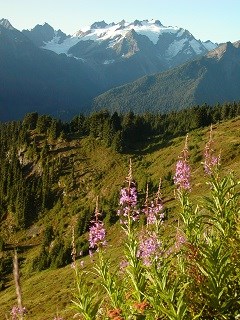Last updated: March 29, 2021
Article
Olympic National Park: World Heritage Site

National Park Service photo.
Olympic National Park features spectacular coastlines, scenic lakes, majestic mountains and glaciers, and magnificent temperate rainforest. Olympic contains a great wealth of geological formations, and its highly varied rainfall has produced a wide range of complex life zones.
This World Heritage Site is isolated from other mountain ranges and surrounded by the waters of the Pacific Ocean and Puget Sound. This isolation has allowed the development of endemic species of plants and animals, including the Olympic marmot, four subspecies of other mammals, two subspecies of trout, and 12 species or varieties of plant. Eleven major river systems drain the Olympic Mountains, offering some of the best habitat for anadromous fish species (such as salmon that live their lives in the sea and migrate to a freshwater river to spawn) in the country.
Olympic exhibits remarkable beauty. It is the largest protected area in the temperate region of the world with a complex ecosystem that ranges from the ocean’s edge through temperate rainforest, alpine meadows, and glaciated mountain peaks.
The mountains of Olympic contain approximately 60 active glaciers. The area is unique because it is the lowest latitude in the world in which glaciers begin at an elevation lower than 2,000 meters (6,500 feet) and exist below 1,000 meters (3,300 feet). The glacier-clad peaks are interspersed with extensive alpine meadows surrounded by old growth forest, among which is the best example of intact and protected temperate rainforest in the Pacific Northwest.
Scattered among the park's breathtaking natural resources are its cultural heritage sites. The Olympic region served as a home for different tribes and groups of people for over twelve thousand years before it was designated a national park in 1938. With artifacts discovered including a spear tip found inside a mastodon, petroglyphs, and a partially woven basket from thousands of years ago, Olympic National Park yields stories of people, proving their habitation in the area beginning about 10,000 BCE. They lived in the mountainous region until the arrival of Europeans and Euro-Americans. A spear point and other signs of human occupation, are the earliest evidence of human presence in this region, and proof that residents 12,000 years ago were hunters. The hunter and gatherer groups who followed early big game hunters also had a strong dependence on the land. From 3,000 to 10,000 years ago, they hunted deer and elk and gathered plants to survive. Their stone tools, left across the peninsula, show that the rugged terrain did not deter them from exploring the entire Olympic ecosystem. By about 3,000 years ago, as the human population increased, early inhabitants shifted their focus to lowland rivers and lakes. Fishing, hunting sea mammals and gathering shellfish formed the foundation of rich and complex maritime cultures for which the Pacific Northwest is known. The forests also provided essentials like food, fibers, medicine and shelter. Crafted from graceful western redcedar trunks were longhouses to protect families from the relentless rain, canoes to hunt seals and whales, baskets, clothing, tools, and bentwood boxes for cooking and storage. Archeological sites, like ones on the Hoko River and at Ozette, contained thousands of wood, shell and bone artifacts that helped modern tribes piece together more of their rich heritage. The skilled workmanship of the artifacts reveal the intimate connection between the artisans, the land and the sea.
Juan de Fuca, a Greek pilot sailing for Spain, may have been the first European to sight the Olympic Peninsula in 1592 when he claimed discovery of the strait now named for him. In the eighteenth century, Spanish, Russian, and English expeditions sailed to the Strait of Juan de Fuca, where they made landfall on and around Olympic National Park. Explorers and settlers from the sixteenth through the eighteenth century surveyed the area, and homesteaders in the late nineteenth century, such as Swedish immigrant Peter Roose, settled among the bountiful forests and streams. The Peter Roose Homestead survives today, including Roose’s modest home and picket fence that is open to the public. Even with its abundance of natural resources and beauty, the area of Olympic National Park never became a heavily permanent settlement area.
After Franklin Roosevelt visited the majestic landscape, he deemed it worthy of national park status and Olympic National Park was established in 1938. The Civilian Conservation Corps (CCC), a depression-era Federal government program, worked to build and establish the accessibility of the park in the 1930s and 1940s so that visitors could explore and enjoy all the park’s features for many years to come. Many buildings have remained from the work of the CCC, such as several ranger stations, depicting the history of the National Park Service itself with the classic rustic look of the 1930s.
Diversity is the hallmark of Olympic National Park -- from the lush canopy of the rain forests, to the sandy beaches of the coast, to the majestic overlooks of the rugged, glacier-capped mountains. With over 922,000 acres, Olympic offers a multitude of activities for its visitors and its visitor center provides information about the park's camping, hiking, fishing, bird watching, and ranger-led activities. Visitors can choose to see the mountains, forests, or coast by means of automobile, backpacking, hiking, camping, and kayaking.
Park Page: https://www.nps.gov/olym/index.htm
World Heritage Information: https://whc.unesco.org/en/list/151
